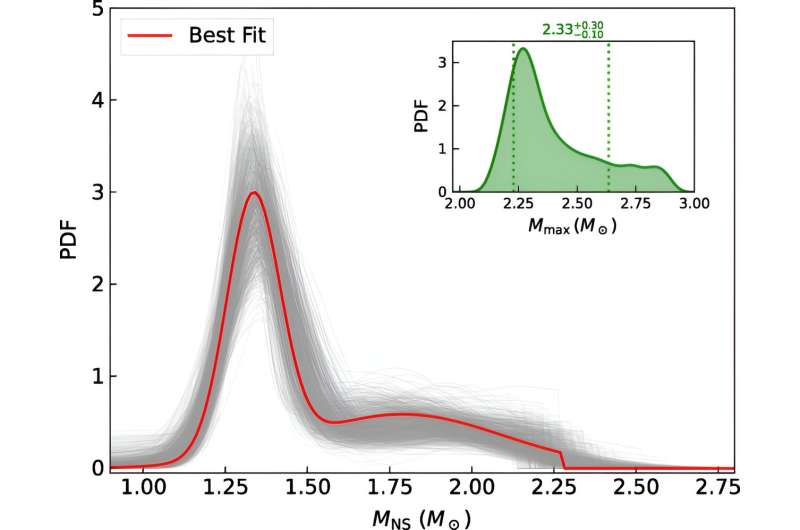This article has been reviewed according to Science X's editorial process and policies. Editors have highlighted the following attributes while ensuring the content's credibility:
fact-checked
peer-reviewed publication
trusted source
proofread
Maximum mass of non-rotating neutron star precisely inferred to be 2.25 solar masses

A study led by Prof. Fan Yizhong from the Purple Mountain Observatory of the Chinese Academy of Sciences has achieved significant precision in determining the upper mass limit for non-rotating neutron stars, a pivotal aspect in the study of nuclear physics and astrophysics.
The researchers showed that the maximum gravitational mass of a non-rotating neutron star is approximately 2.25 solar masses with an uncertainty of just 0.07 solar mass. Their study is published in Physical Review D.
The ultimate fate of a massive star is intricately linked to its mass. Stars lighter than eight solar masses end their life cycle as white dwarfs, supported by electron degeneracy pressure with a well-known upper mass limit, the Chandrasekhar limit, near 1.4 solar masses.
For stars heavier than eight but lighter than 25 solar masses, neutron stars will be produced, which instead, are mainly upheld by neutron degeneracy pressure. For non-rotating neutron stars, there is also a critical gravitational mass (i.e., MTOV) known as the Oppenheimer limit, above which the neutron star will collapse into a black hole.
Establishing a precise Oppenheimer limit is quite challenging. Only loose bounds can be set based on the first principle. Many specific evaluations are strongly model-dependent. The resulting MTOV are diverse and the uncertainties are large.
Prof. Fan's team has refined the inference of MTOV by incorporating robust multi-messenger observations and reliable nuclear physics data, circumventing the uncertainties present in earlier models. This includes leveraging recent advancements in mass/radius measurements from LIGO/Virgo gravitational-wave detectors and the Neutron star Interior Composition Explorer (NICER).
In particular, they incorporated the information of the maximum mass cutoff inferred from the neutron star mass distribution and significantly narrowed the parameter space, leading to an unprecedented precision in the inferred MTOV. Three diverse equation of state (EoS) reconstruction models were employed to mitigate potential systematic errors, yielding almost identical results for MTOV and the corresponding radius, which is 11.9 km with an uncertainty of 0.6 km in three independent EoS reconstruction approaches.
The precise evaluation of MTOV carries profound implications for both nuclear physics and astrophysics. It indicates a moderately stiff EoS for neutron star matter and suggests that the compact objects with masses in the range of approximately 2.5 to 3.0 solar masses, detected by LIGO/Virgo, are more likely to be the lightest black holes. Furthermore, the merger remnants of binary neutron star systems exceeding a total mass of roughly 2.76 solar masses would collapse into black holes, while lighter systems would result in the formation of (supramassive) neutron stars.
More information: Yi-Zhong Fan et al, Maximum gravitational mass MTOV=2.25−0.07+0.08M⊙ inferred at about 3% precision with multimessenger data of neutron stars, Physical Review D (2024). DOI: 10.1103/PhysRevD.109.043052. On arXiv: DOI: 10.48550/arxiv.2309.12644
Journal information: Physical Review D , arXiv
Provided by Chinese Academy of Sciences





















